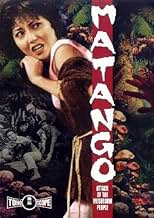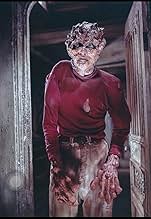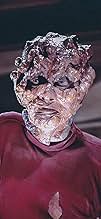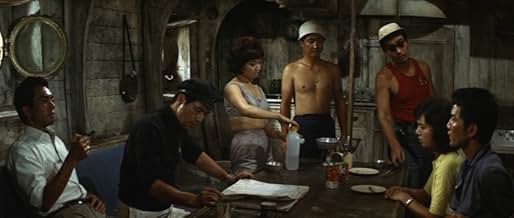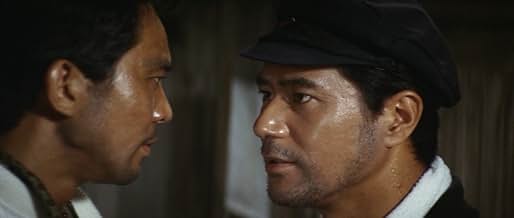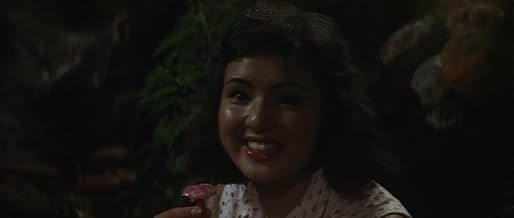IMDb RATING
6.4/10
3.8K
YOUR RATING
Shipwrecked survivors slowly transform into mushrooms.Shipwrecked survivors slowly transform into mushrooms.Shipwrecked survivors slowly transform into mushrooms.
Takuzô Kumagai
- Doctor
- (as Jirô Kumagai)
Featured reviews
Purely because not all their contemporary monster movies could feature big mutated lizards (Godzilla), flying turtles (Gamera) or humongous moths (Mothra), the Japanese also made a monster movie with giant
mushrooms! Well, I say "the Japanese" but basically it's once again just the one and only legendary director Ishirô Honda who was responsible for yet another imaginative and extremely entertaining cult classic. Honda was an amazingly talented director and he single-handedly directed Japan's finest genre milestones. So
mushrooms! Yes I know this sounds incredibly idiotic and the international title "Attack of the Mushroom People" also strengthens the suspicion that we're dealing with a silly and light-headed B-movie, but this honestly is a very competent and admirably atmospheric tale of terror! Seven prominent citizens, including a university professor, a writer and a famous pop singer, turn their back on the stress of Tokyo for a holiday on a luxurious sailing yacht. There's a lot of flirting, laughing and "La La La La" singing on board, but then a massive thunderstorm turns their yacht into a heavily damaged piece of driftwood and the group washes ashore a mysterious fog-enshrouded island. With a food supply of barely one week, the group rapidly falls apart due to intrigues and selfishness, and what's the deal with those ominous mushrooms that grow all around the island? They also stumble upon a large and stranded research vessel that is overgrown with fungus and the same damn mushrooms! The survivors instinctively know they shouldn't eat them, but what else are they supposed to do when there's no more food? I consider myself very lucky and privileged because I was able to see the original Japanese-language version of "Matango" on a big cinema screen, during a little festival in my country with a focus on botanical- themed horror movies. Granted, the picture quality was quite creaky and the film was interrupted every 10 minutes due to technical reasons, but the charm and nostalgia value of an early '60s film on the big screen is irreplaceable! The concept of the film is one of the most original in horror cinema history, and director Honda maintains an unsettling atmosphere throughout. He achieves this thanks to subtle camera work, eerie sound effects & music, embittered character drawings and frightening monster designs and set pieces. Yes, the mushroom-monsters definitely DO look creepy and the large vessel is truly nightmarish!
When I first saw this film on a local late-night horror movie show, it was the late 1960s and our family hadn't yet purchased a color TV. Growing up with films and TV shows produced and viewed in B&W made me sensitive to the unique qualities of this medium, particularly the way in which it focuses the viewer's attention on the quality and play of light. It is this element of "Matango" which most impressed methe cold ethereal light of the fog-shrouded forest covered in great lumps of pallid fungus sent a real shiver down my back. Although I had cut my teeth on such midnight horror movies, this one actually stole away my sleep for a couple nights!
Over time I had lost track of this film. The Saturday Night horror show became a thing of the past and no one seemed interested in rebroadcasting these old films. Then very recently, on a lark, I asked our local (independent) video rental place if they had this film in their data base, and Lo! there it was, available on VHS. They ordered it, held it for me, I rented it and prepared to sit down and be scared by it again after a hiatus of over 25 years.
Imagine my surprise to find that the film is in color! In color, it didn't have the same impact at all as it did when I watched it on our B&W TV back home. Quickly, before it got too deep into the story, I changed all the settings on my TV to a nicely balanced black and white, and WOW! There it was, the scariness, the moodiness, the mystery, and the visual subtleties which make it a very nice piece of art.
Really, folksyou gotta see this film in black and white to really appreciate how well it was photographed, lighted, constructed and dressed. This is quite a gem of a film, but one which should have been in black and white to begin with.
Over time I had lost track of this film. The Saturday Night horror show became a thing of the past and no one seemed interested in rebroadcasting these old films. Then very recently, on a lark, I asked our local (independent) video rental place if they had this film in their data base, and Lo! there it was, available on VHS. They ordered it, held it for me, I rented it and prepared to sit down and be scared by it again after a hiatus of over 25 years.
Imagine my surprise to find that the film is in color! In color, it didn't have the same impact at all as it did when I watched it on our B&W TV back home. Quickly, before it got too deep into the story, I changed all the settings on my TV to a nicely balanced black and white, and WOW! There it was, the scariness, the moodiness, the mystery, and the visual subtleties which make it a very nice piece of art.
Really, folksyou gotta see this film in black and white to really appreciate how well it was photographed, lighted, constructed and dressed. This is quite a gem of a film, but one which should have been in black and white to begin with.
Toho are mostly known for their dark bleak period pieces and their goofy monster flicks, but every once in a while they delved into something else and Matango is a great example of this.
Well ahead of its time it tells the story of ship wreck survivors trying to make it until help comes, but they don't appear to be alone on the island and tensions are beginning to build.
So okay I admit the concept is daft, the antagonists are a bit silly but lets be honest they aren't a million miles from those in The Last of Us (2013). Despite this they actually do the job quite well and look considerably better than you'd imagine considering this was the early 60's.
The film is a real slow burner and very little of it features the antagonists at all, the majority is the turmoil between survivors but it does this to a passable degree.
Though not everything it could have been there is a lot to be impressed over in Matango and it's a neat little forgotten Toho movie that deserves attention.
The Good:
Looks excellent for its time
Some good ideas
The Bad:
Cast and characters are pretty forgettable
Very slow burn
Things I Learnt From This Movie:
An opportune time to tell a woman you love her for the first time is straight after hitting her
Could easily have had a sequel about killer cheese people
Well ahead of its time it tells the story of ship wreck survivors trying to make it until help comes, but they don't appear to be alone on the island and tensions are beginning to build.
So okay I admit the concept is daft, the antagonists are a bit silly but lets be honest they aren't a million miles from those in The Last of Us (2013). Despite this they actually do the job quite well and look considerably better than you'd imagine considering this was the early 60's.
The film is a real slow burner and very little of it features the antagonists at all, the majority is the turmoil between survivors but it does this to a passable degree.
Though not everything it could have been there is a lot to be impressed over in Matango and it's a neat little forgotten Toho movie that deserves attention.
The Good:
Looks excellent for its time
Some good ideas
The Bad:
Cast and characters are pretty forgettable
Very slow burn
Things I Learnt From This Movie:
An opportune time to tell a woman you love her for the first time is straight after hitting her
Could easily have had a sequel about killer cheese people
First a correction : the making year and distribution release year in Japan of MATANGO is 1962 and not 1963. It is of course a very good movie from Inoshiro Honda, the father of "Kaiju Eiga" and every cinephile knows what that means. Besides, it is a "Kaiju eiga" (= "monster movie" as trasnlated in English) quite closer to horror than to science-fiction, even it is also a sci-fi, including mentions of the atom research in the ghost boat in which the survivors are living. It is closer to BINJO TO EKITAI NINGEN [L'HOMME H] (Jap. 1958) than to GOJIRA (Jap. 1954), both directed by Honda, if you want to have a comparative idea. Anyway, it is a very original movie in Honda carrier. Even it can remind, as a cultivate reader mentionned it, a W.H.Hodgson's novel. But were the Japanese scriptwriters aware of that source ? Interesting question. I am glad to announce you that in France, a smart distributor has bought the rights from Toho and distributed that movie in a beautiful Cinemascope complying with 16/9 TV screening : it has been shown on Canal + private famous French TV but I do not think it is available on DVD or video.
It was around one or two years ago and we have been able to discover it in original japanese langage with French subtitles : beautiful master and beautiful movie. Honda is my favorite horror and sci-fi movie director with regard to history of Japanese movie. I have recently written an "Elementary filmography of Kaiju Eiga" in which Inoshiro Honda has of course the main place, as far as Toho is concerned. MATANGO is a masterpiece.
It was around one or two years ago and we have been able to discover it in original japanese langage with French subtitles : beautiful master and beautiful movie. Honda is my favorite horror and sci-fi movie director with regard to history of Japanese movie. I have recently written an "Elementary filmography of Kaiju Eiga" in which Inoshiro Honda has of course the main place, as far as Toho is concerned. MATANGO is a masterpiece.
MATANGO, directed by Ishiro Honda, is an exceptionally beautiful fantasy film from the mighty Toho. Bastardized for its American release, badly dubbed, retitled ("Attack of the Mushroom People") and afforded very little respect, its recent re-emergence as a special edition DVD confirms its place in the realm of fantastique cinema.
What makes this amazing film so effective is its seductively spare but intelligent screenplay, nightmarish atmosphere, serenely creepy score and stunning special effects. Tonally, it recalls underrated Japanese genre flicks such as "The Mistress in a Cave", "Horror of Malformed Men" and the delightful "Living Skeleton". Like the mushrooms the shipwrecked survivors of a pleasure craft are drawn to, it seduces us with its simple structure, pleasing taste and rich subtext.
The film operates on a number of thematic levels, but Honda's achievement is that he never allows the dense thematics to weigh the very human drama down. Like all classic stories of survival, human greed, envy, love and hunger are the engines of the conflict. The search for a state of being free of responsibility and consequences is the dream driving the conflicted.
It is of curious interest to me that the characters in this "uncharted island" fantasy include a Skipper, a Millionaire, a Professor, a First Mate and a Girl Next Door. Produced before "Gilligan's Island" debuted on American TV, it could surely be argued that this orchestration of characters was a template for Sherwood Schwartz, the creator of "Gilligan's Island".
A palpable sadness permeates the last twenty minutes of MATANGO, a sense of blinding melancholy that elevates it to a dizzying level of achievement.
MATANGO explores how we are all drawn to pleasures that we know may sign our death warrants while daring to suggest that death by pleasure is a demise more preferable to death without love.
Stunning.
What makes this amazing film so effective is its seductively spare but intelligent screenplay, nightmarish atmosphere, serenely creepy score and stunning special effects. Tonally, it recalls underrated Japanese genre flicks such as "The Mistress in a Cave", "Horror of Malformed Men" and the delightful "Living Skeleton". Like the mushrooms the shipwrecked survivors of a pleasure craft are drawn to, it seduces us with its simple structure, pleasing taste and rich subtext.
The film operates on a number of thematic levels, but Honda's achievement is that he never allows the dense thematics to weigh the very human drama down. Like all classic stories of survival, human greed, envy, love and hunger are the engines of the conflict. The search for a state of being free of responsibility and consequences is the dream driving the conflicted.
It is of curious interest to me that the characters in this "uncharted island" fantasy include a Skipper, a Millionaire, a Professor, a First Mate and a Girl Next Door. Produced before "Gilligan's Island" debuted on American TV, it could surely be argued that this orchestration of characters was a template for Sherwood Schwartz, the creator of "Gilligan's Island".
A palpable sadness permeates the last twenty minutes of MATANGO, a sense of blinding melancholy that elevates it to a dizzying level of achievement.
MATANGO explores how we are all drawn to pleasures that we know may sign our death warrants while daring to suggest that death by pleasure is a demise more preferable to death without love.
Stunning.
Did you know
- TriviaThe film was nearly banned in Japan. The makeup some characters wore as they were turning into humanoid mushroom creatures was very similar to how many Japanese people looked after the atomic bombings of Hiroshima and Nagasaki.
- GoofsWhen Kasai shoots at Yoshida and Mami as he chases them off the boat, you can see the bullets ricochet off the ground before he even fires a shot.
- Crazy creditsThe opening credits of the Japanese version are on animated sailboat sails.
- ConnectionsEdited into Gli ultimi giorni dell'umanità (2022)
- How long is Matango?Powered by Alexa
Details
- Release date
- Country of origin
- Language
- Also known as
- Attack of the Mushroom People
- Filming locations
- Production company
- See more company credits at IMDbPro
- Runtime1 hour 29 minutes
- Sound mix
- Aspect ratio
- 2.55 : 1
Contribute to this page
Suggest an edit or add missing content

